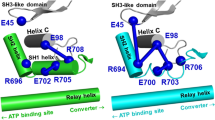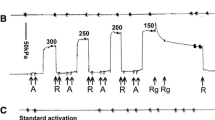Abstract
Current theories of muscle cross-bridge function suggest that force is generated by a change in the orientation of the myosin neck region. We attached a paramagnetic probe to a subunit in the neck region and measured the orientation of the probe using electron paramagnetic resonance spectroscopy. The angle of the probes on smooth myosin S1 were changed by 20°±4° on addition of ADP (50% effect at 5±2 μM), but ADP produced little effect on skeletal S1. The orientation of smooth myosin, +ADP, resembled that of skeletal myosin, ±ADP, suggesting that the release of ADP generates an extra rotation of the neck region in smooth muscle at the end of its power stroke.
Similar content being viewed by others
References
Cooke, R. The mechanism of muscle contraction. Critical Reviews in Biochemistry 21, 53–118 (1996).
Goldman, Y.E. Kinetics of the actomyosin ATPase in muscle fibers. Ann. Rev. Physiol. 49, 637–654 (1987).
Kabsch, W., Mannherz, H.G., Suck, D., Pai, E.F. & Holmes, K.C. Atomic structure of the actin DNase complex. Nature 347, 37–44 (1990).
Rayment, I. et al. Three-dimensional structure of myosin subfragment-1: A molecular motor. Science 261, 50–57 (1993).
Lorenz, M., Popp, D. & Holmes, K.C. Refinement of the F-actin model against X-ray fiber diffraction data by the use of a directed mutation algorithm. J. Mol. Biol. 234, 826–836 (1993).
Holmes, K.C., Popp, D., Gebhardt, W. & Kabsch, W. Atomic model of the actin filament. Nature 347, 44–49 (1990).
Schroder, R.R. et al. Three dimensional atomic model of F-actin decorated with Dictyostelium myosin S1. Nature 364, 171–174 (1993).
Rayment, I. et al. Structure of the actin-myosin complex and its implications for muscle contraction. Science 261, 58–65 (1993).
Cooke, R., Crowder, M.S. & Thomas, D.D. Orientation of spin labels attached to cross-bridges in contracting muscle fibers. Nature 30, 776–778 (1982).
Tanner, J.W., Thomas, D.W. & Goldman, Y.E. Transients in orientation of a fluorescent cross-bridge probe following photolysis of caged nucleotides in skeletal muscle fibers. J. Mol. Biol. 223, 185–203 (1992).
Roopnarine, O. & Thomas, D.D. Orientational dynamics of indane dione spin-labeled myosin heads in relaxed and contracting skeletal muscle fibers. Biophys. J. 68, 1461–1471 (1995).
Yanagida, T. Angle of active site of myosin heads in contracting muscle during sudden length changes. J. Mus. Res. Cell Motility 6, 43–52 (1985).
Zhao, L., Pate, E., Baker, A.J. & Cooke, R. The myosin catalytic domain does not rotate during the working power stroke. Biophys. J. 69, 994–999 (1995).
Trybus, K.M. Regulation of expressed truncated smooth muscle myosins.Role of the essential light chain and tail length. J. Biol. Chem. 269, 20819–20822 (1994).
Lowey, S., Waller, G.S. & Trybus, K.M. Skeletal muscle myosin light chains are essential for physiological speeds of shortening. Nature 365, 454–456 (1993).
Whittaker, M. et al. A 35-angstrom movement of smooth muscle myosin on ADP release. Nature 378, 748–751 (1995).
Uyeda, T.Q.P., Abramson, P.O. & Spudich, J.A. The neck region of the myosin motor domain acts as a lever arm to generate movement. Proc. Natl. Acad. Sci. USA 93, 4459–4464 (1996).
Irving, M. et al. Tilting of the light-chain region of myosin during step length changes and active force generation in skeletal muscle. Nature 375, 688–691 (1995).
Jontes, J.D., Wilson-Kubalek, E.M. & Milligan, R.A. A 32-degrees tail swing in brush border myosin I on Adp release. Nature 378, 751–753 (1995).
Thomas, D.D. Spectroscopic probes of muscle cross-bridge rotation. Annu. Rev. Physiol. 46, 691–709 (1987).
Thomas, D.D. & Cooke, R. Orientation of spin-labeled myosin heads in glycerinated muscle fibers. Biophys. J. 32, 891–906 (1980).
Barnett, V.A., Fajer, P., Polnaszek, C.F. & Thomas, D.D. High-resolution detection of muscle crossbridge orientation by electron paramagnetic resonance. Biophys. J. 49, 144–146 (1986).
Ling, N., Shrimpton, C., Sleep, J., Kendrick-Jones, J. & Irving, M. Fluorescent probes of the orientation of myosin regulatory tight chains in relaxed, rigor, and contracting muscle. Biophys. J. 70, 1836–1846 (1996).
Clark, J.F., Kemp, G.J. & Radda, G.K. The creatine kinase equilibrium, free [Adp] and myosin atpase in vascular smooth muscle cross-bridges. J. Theoretical Biol. 173, 207–211 (1995).
Nishiye, E., Somlyo, A.V., Torok, K. & Somlyo, A.P. The effects of MgADP on cross-bridge kinetics: a laser flash photolysis study of guinea-pig smooth muscle. J. Physiol. 460, 247–71 (1993).
Fuglsang, A., Khromov, A., Torok, K., Somlyo, A.V. & Somlyo, A.P. Flash photolysis studies of relaxation and cross-bridge detachment: higher sensitivity of tonic than phasic smooth muscle to MgADP. J. Musc. Res. Cell Motility 14, 666–677 (1993).
Greene, L.E. & Sellers, J.R. Effect of phosphorylation on the binding of smooth mscle heavy meromyosin X ADP to actin. J. Biol. Chem. 262, 4177–4181 (1987).
Griffith, O.H. & Jost, P.C. In Spin Labeling: Theory and Applications (ed. Berliner, U.) 454–519 (Academic Press: New York, 1976).
Geeves, M.A. The dynamics of actin and myosin association and the crossbridge model of muscle contraction. Biochem. J. 274 1–14 (1991).
Allen, T.S., Ling, N., Irving, M. & Goldman, Y.E. Orientation changes in myosin regulatory light chains following photorelease of atp in skinned musclefibers. Biophys. J. 70, 1847–1862 (1996).
Hambly, B., Franks, K. & Cooke, R. Paramagnetic probes attached to a light chain on the myosin head are highly disordered in active muscle fibers. Biophys. J. 63, 306–313 (1992).
Ikebe, M. & Hartshorne, D.J. Effects of Ca2+ on the conformation and enzymatic activity of smooth muscle myosin. J. Biol. Chem. 260, 13146–13153 (1985).
Facemyer, K.C. & Cremo, C.R. A new method to specifically label thiophosphorylatable proteins with extrinsic probes. Labeling of serine-19 of the regulatory light chain of smooth muscle myosin. Bioconjugate Chem. 3, 408–413 (1992).
Cremo, C.R., Sellers, J.R. & Facemyer, K.C. Two heads are required for phosphorylation-dependent regulation of smooth muscle myosin. J. Biol. Chem. 270, 2171–2175 (1995).
Ikebe, M. & Hartshorne, D.J. Proteolysis of smooth muscle myosin by Staphylococcus aureus protease: preparation of heavy meromyosin and subfragment 1 with intact 20 000-dalton light chains. Biochemistry 24, 2380–2387 (1985).
Cooke, R. A new method for producing myosin subfragment-1. Biochem. Biophys. Res. Commun. 49, 1021–1028 (1972).
Morita, J.-I., Takashi, R. & Ikebe, M. Exchange of the fluorescence-labeled 20,000-Dalton light chain of smooth muscle myosin. Biochemistry, 30 9539–9545 (1991).
Trybus, K.M. & Chatman, T.A. Chimeric regulatory light chains as probes of smooth muscle myosin. J. Biol. Chem. 268, 4412–4419 (1993).
Goldman, S.A., Bruno, G.V. & Freed, J.H. Estimating slow-motional rotational correlation times for nitroxides by electron spin resonance. J. Phys. Chem. 76, 1858–1860 (1972).
Fajer, P.G., Bennett, R.L.H., Polnaszek, C.F., Fajer, E.A. & Thomas, D.D. General method for multiparameter fitting of high-resolution EPR spectra using a simplex algorithm. J. Mag. Res. 88, 111–125 (1990).
Author information
Authors and Affiliations
Rights and permissions
About this article
Cite this article
Gollub, J., Cremo, C. & Cooke, R. ADP release produces a rotation of the neck region of smooth myosin but not skeletal myosin. Nat Struct Mol Biol 3, 796–802 (1996). https://doi.org/10.1038/nsb0996-796
Received:
Accepted:
Issue Date:
DOI: https://doi.org/10.1038/nsb0996-796
- Springer Nature America, Inc.
This article is cited by
-
From amino-acid to disease: the effects of oxidation on actin-myosin interactions in muscle
Journal of Muscle Research and Cell Motility (2023)
-
Towards a Unified Theory of Muscle Contraction. I: Foundations
Annals of Biomedical Engineering (2008)
-
An actin-dependent conformational change in myosin
Nature Structural & Molecular Biology (2003)
-
Load-dependent kinetics of force production by smooth muscle myosin measured with optical tweezers
Nature Cell Biology (2003)
-
Myosin isoforms show different strokes for different blokes
Nature Structural & Molecular Biology (1996)





